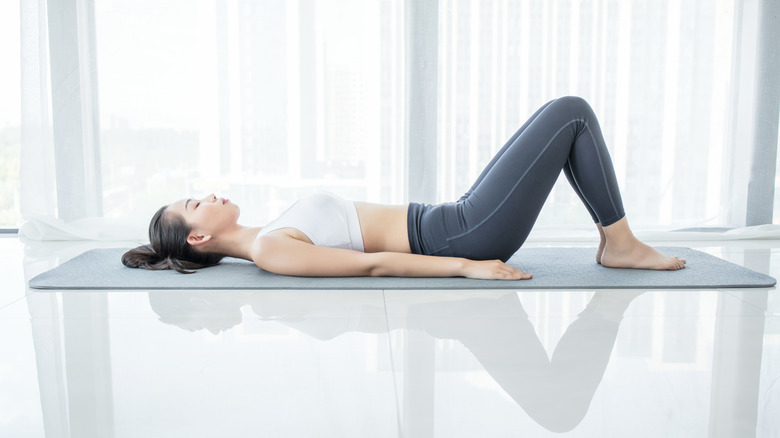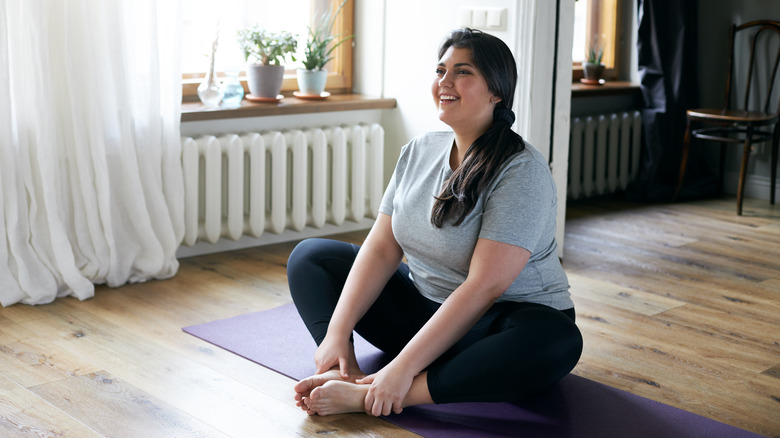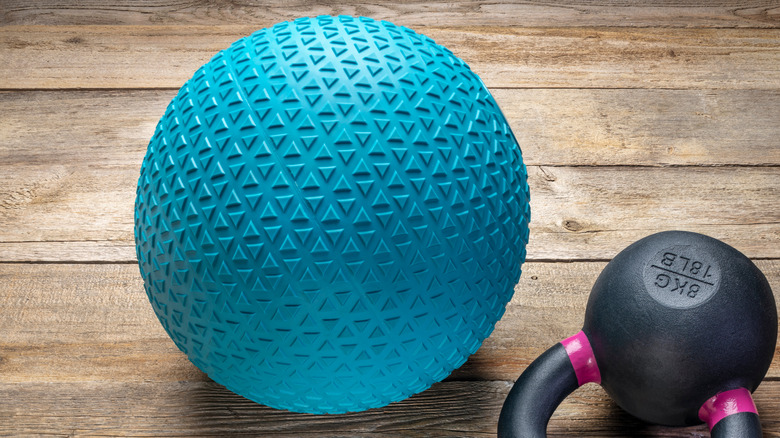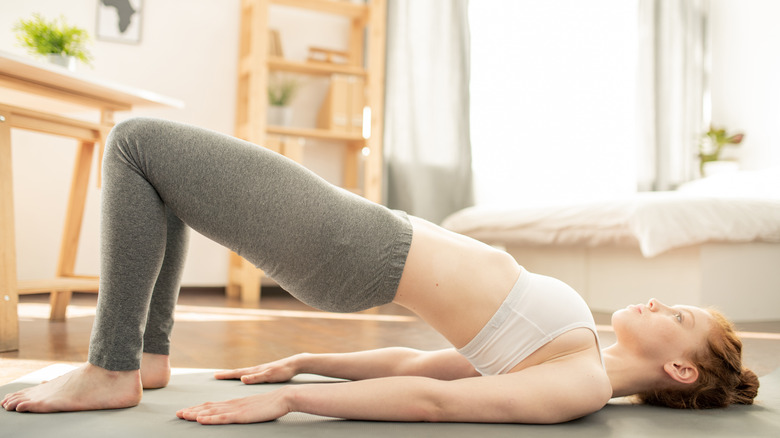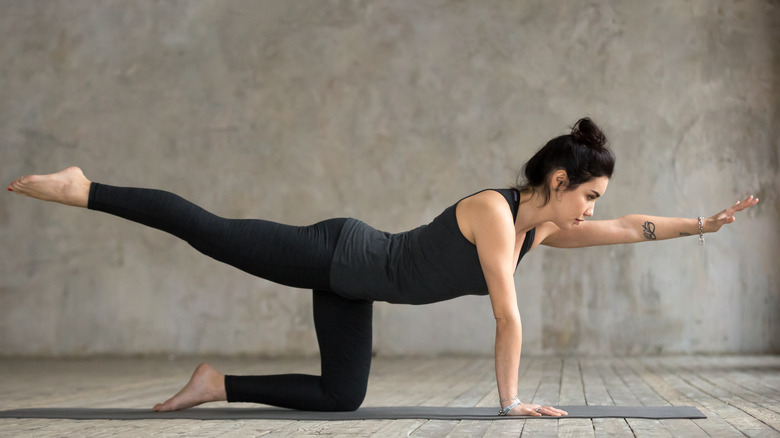The Best Exercises To Help Improve Bladder Control
Urinary incontinence can affect every aspect of your life, including your work, sleep, relationships, and fitness routine. Even mundane things like taking a walk or attending a meeting can seem like a chore. Sadly, more than 50% of American women will experience this condition at some point in their lives, according to clinical research published in JAMA Internal Medicine. Its causes range from aging, childbirth, and menopause to lifestyle factors and underlying disorders.
In some cases, sufferers experience a temporary loss of bladder control. For example, men and women may develop this problem due to urinary tract infections, explains the National Institute of Diabetes and Digestive and Kidney Diseases (NIDDK). In other cases, urinary incontinence can result from nerve damage following a stroke, spinal cord injuries, or vaginal childbirth.
This distressing condition also tends to affect women with weak pelvic floor muscles, says the NIDDK. A weak pelvic floor can reduce the bladder's ability to hold urine, causing leaks when you sneeze, laugh, run, jump, or lift heavy objects.
Given these aspects, it makes sense to focus on building stronger pelvic floor muscles. The Mayo Clinic Health System recommends working with a pelvic floor physical therapist before considering other treatment options, such as intravaginal pessaries. Also, there are a few types of exercises you can try at home to help improve bladder control.
Start with Kegel exercises
Kegel exercises can strengthen the pelvic floor in both men and women. In the long run, they may help reduce or eliminate bladder leakage, improve pelvic stability, and relieve urinary urgency, according to the National Association for Continence (NAFC). Moreover, Kegels can benefit those with bowel incontinence or cystocele, rectocele, and other types of pelvic organ prolapse, says the University of Chicago Medical Center.
To get started, lie on your back and try to find your pelvic floor muscles. These are the muscles you'd normally use to stop your urine stream. Squeeze them for five seconds, relax them for another five seconds, and then do it again. Aim for about five reps per day.
As you progress, try to squeeze and relax your pelvic floor muscles for 10 seconds at a time — and complete up to 10 reps, suggests the NAFC. Work your way up to three sets of 10 reps per day to fully reap the benefits. For best results, do your Kegels on an empty bladder and be consistent with your routine. Once you've got the hang of it, you should be able to do this exercise anytime, anywhere.
Squeeze and release
Any woman can benefit from pelvic floor training, as these exercises help strengthen the muscles that support her bladder, bowel, and womb. The Royal Women's Hospital recommends working your pelvic floor muscles daily, even if you don't have bladder problems. This practice can improve your ability to hold in urine while reducing the risk of organ prolapse. In addition to Kegels, you can try the following exercise for better bladder control.
Lie on your back and squeeze your pelvic floor muscles as quickly as you can. Release them, rest for a few seconds, and repeat. Complete 10 to 20 reps per day, suggests the Royal Women's Hospital. Remember to breathe and keep your thigh muscles relaxed. Don't squeeze your buttocks. Instead, focus on the muscles in your pelvic area.
The Urology Care Foundation recommends inserting one or two fingers into your vagina while lying down if you're having trouble finding your pelvic floor muscles. Contract the muscles around your finger so you can feel them moving. You should experience the same sensation when doing your Kegels or other pelvic floor exercises.
Try the pelvic floor ball squeeze
The pelvic floor muscles are not too different from other muscles in your body, and they require constant stimulation to stay strong. You can even use a small ball or resistance bands to work these muscles and keep them functioning optimally.
For example, you could try to squeeze an exercise ball between your thighs while standing or sitting down. Tighten your pelvic floor as you squeeze the ball and hold the contraction for about 10 seconds, suggests the University of Miami Health System. Release and repeat. As your muscles get stronger, work your way up to 10 reps.
You may also perform this exercise while in bed. Lie on your back with a small ball between your knees and then squeeze it, recommends Pilates Lifestyle. Take five breaths, tightening your pelvic floor muscles harder with each breath. Relax, exhale five times, and start all over. Complete five or more reps.
Add glute bridges to your workout routine
The glute bridge activates the gluteal muscles and builds core strength, explains the National Association of Sports Medicine (NASM). What you may not know is that it also engages the pelvic floor muscles, which may help prevent or reduce urinary incontinence, according to pelvic floor physical therapist Jen Sant (via YouTube). Plus, you can gradually increase the resistance by adding a dumbbell or elastic bands to the mix.
First, lie down on your back with your knees bent and your feet hip-width apart. Tighten your core and buttocks while lifting your hips as high as you can. Maintain a neutral spine and take deep breaths as you lift and lower your hips back to the floor. Try to feel your pelvic floor muscles when squeezing your abs and move in a slow, controlled manner without arching your back.
For best results, squeeze your glutes harder at the top of the movement and hold the contraction for two seconds or so, suggests the NASM. As you progress, you can wrap an elastic band around your thighs or place a dumbbell on your hips to make the exercise more challenging. Complete up to three or four sets of eight to 12 reps each.
Strengthen your pelvic floor with the bird-dog exercise
This simple bodyweight exercise works your abs, pelvic floor, and lower back muscles, which may help improve bladder control. At the same time, it can improve your posture, enhance your balance, and prevent or reduce low back pain (via TENA). Moreover, it's suitable for all fitness levels and requires no equipment.
Start on all fours, with your back straight and your hips aligned with your knees. Next, try to simultaneously lift your right arm and left leg without bending your back or moving your hips. At the same time, brace your core muscles, including the pelvic floor. Maintain the contraction for a few seconds, return to the starting position, and lift your right arm and left leg. Hold this position for a moment, bring your arm and leg back down to the floor, and repeat.
If you have trouble keeping your balance, the NAFC recommends extending only your arm or leg at first. What matters most is to squeeze your core and use your abs to control the movement. As your balance improves, you can use a light dumbbell for increased resistance. Basically, you'll raise your arm (and the opposite leg) while holding a dumbbell — and then switch sides.


